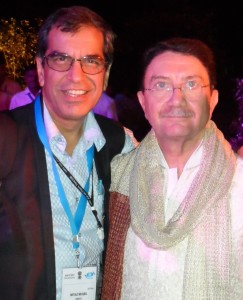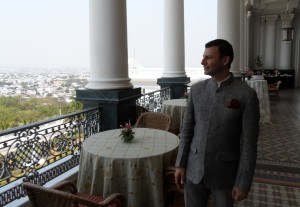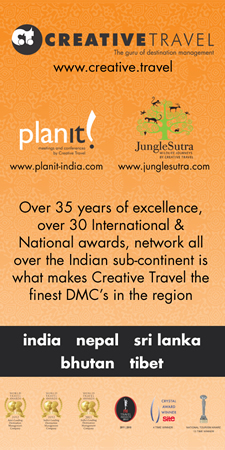
24 Apr, 2013
UNWTO’s Most Spectacular Asia-Pacific Meeting Venue: Hyderabad’s “Mirror in the Sky”
Hyderabad, Andhra Pradesh, India — If there is one over-arching reason why delegates will never forget the UNWTO’s Joint Commission meetings of South Asia, East Asia and the Pacific held here between 12-14 April 2013 it is because of the spectacular venue, the Taj Falaknuma Palace hotel, the jewel in the crown of the palatial hotels that the Taj group operates in India.
Convening at the world’s longest dining table, capable of seating 101 people over a length of 108-feet, the delegates were warned at the outset of the meeting that the hall’s acoustics were so perfect that even a whisper at one end could be heard at the other, in the absence of any other sounds or noise.
During a later tour of the hotel, which are organised daily, the delegates were awestruck to be told by the hotel’s resident historian, Mr. Prabhakar, that when he first saw the place in 1995, it was in a state of decrepit ruin, infested with rats and wildlife, dust and grime, and pools of dirty water. Once owned and inhabited by several Nizams of Hyderabad, one of whom was considered the world’s richest man, the former majestic palace had fallen into disrepair due to four decades of neglect, from the 1950s to the 1990s.
It took 10 years, 180 crores Indian rupees and, most importantly, an immense amount of visionary patience and determination by the descendants of the late Nizam of Hyderabad and the Tata group, the owning company of Taj Hotels, to restore it to its former glory in such perfect detail as to be almost indistinguishable from the original.

UNWTO Secretary General Dr Taleb Rifai (right) and Travel Impact Newswire Executive Editor Imtiaz Muqbil
Converted from a palace to a hotel, and re-opened in November 2010, the 60 rooms and numerous halls are resplendent with ornate furniture, rich handcrafted tapestries, Venetian chandeliers and intricate frescos, wooden ceilings, parquet flooring, regal walnut wood furniture, handcrafted mirrors and rare artefacts, including paintings, statues, furniture, manuscripts and books. Records show that many of these items and artefacts cannot be found anywhere else in the world. The photographs above, all taken by Imtiaz Muqbil, testify to the grandeur of the venue.
Opening the Joint Commission meeting, UNWTO Secretary General Dr Taleb Rifai declared it to be the “most spectacular” venue ever for a UNWTO event. He thanked the Indian and Andhra Pradesh tourism authorities and the Taj group for making the historic occasion possible. Further details of its history and restoration have been documented here on the Taj website and in a Wikipedia entry.
The name “Falak-numa” originates in Urdu and means “Mirror in the Sky”, traceable to the palace’s location on a 2,000-foot hillock, affording a panoramic view of Hyderabad city.
General Manager Girish Sehgal, 36, says the hotel is owned by one of the Nizam’s trusts, set up to manage the estates in the aftermath of the Indian independence movement and the nationalisation of the former royal properties. With a 30-year lease contract, the Taj is working hard to raise the property’s profile. “We have now created credibility that we are the best partners for any of the former royal families to give their properties.”

Girish Sehgal, GM, Taj Falaknuma Palace, Hyderabad
He says the Falaknuma will go a long way towards putting Hyderabad on the map as a destination for high-end visitors, especially luxury travellers and upmarket events, incentives and conferences. While other Taj palace hotels are located in already established destinations such as Udaipur and Jaipur, Hyderabad was nowhere in the picture for attracting high-spending clientele. That will change, and allow Indian tourism authorities to emphasise another destination in addition to the better known spots such as Agra and Kerala.
“We are quite fortunate to be making a small contribution to that effort,” he said. “This is the grandest palace hotel in the Taj group. We are naturally proud of all the other properties but this is definitely the most spectacular in terms of the richness of the interiors.”
Mr. Sehgal, who has a passion for history, said there is a lot more to be discovered in Hyderabad itself in terms of monuments, cuisine and Indian history and heritage. Within the hotel grounds, too, beautiful Japanese gardens are being restored along with a Coronation Hall which will display works of Indian artists.

Travel Impact Newswire dispatches on India are sponsored by Creative Travel, India. Click on the logo for more details.
Indeed, he said, the Falaknuma has become a destination in itself, increasingly gaining the attention of tour operators, conference and incentive organisers. Even if events are held at other Hyderabad hotels, organisers seek to include a dinner or reception at the Falaknuma.
In addition to getting some private charters on a regular basis, Mr. Sehgal said the domestic Indian market is a big source of support. “There is a lot of wealth in this country and we are attracting a lot of events and celebrations, such as weddings and birthdays. We have been told that when guests find that the event is being held here, they get 100% attendance.”
Later, this editor took the opportunity to sign the guest book, and found it 90% filled with Indian names, including Aishwarya Rai Bachchan and Sachin Tendulkar. One of the more notable foreign luminaries was Nelson Mandela.
Mr. Sehgal said the promotion of Hyderabad would get a further fillip if the former Nizam’s jewellery collection could be brought out of the vault of the Indian central bank for public display. One choice piece includes the 186-carat Jacob’s diamond which the former Nizam once used as a paperweight. “You can imagine what such an exhibition would do to attract high net-worth clients.”
Room rates at the hotel range from IR25,000 to IR800,000. The average occupancy was about 40% in 2012 and is projected at 50% this year. The hotel has 260 staff, with an average age of 24-25. While some have relocated from other Taj properties for a chance to work at the Falaknuma, most of the others were hired from the colleges and hospitality training institutes of Hyderabad itself.
One major challenge is keeping the entire place clean. That job has been outsourced to a Hyderabad company and involves reviving what is an art in itself.
Now at the Taj Falaknuma for a year and with the Taj for five years, Mr. Sehgal was previously with the Taj in the Maldives. Born into a military family in the northern Indian hill station of Dehra Dun, Mr Sehgal veered away from medicine or engineering or some of the conventional fields favoured by most Indian families, and opted for a career in hospitality, which he correctly identified as an upcoming sector. Winning a scholarship helped him get into the field.
He worked in the United States, Canada, the Bahamas and the Maldives, mostly with the Four Seasons chain. He joined the Taj both so that he could return to India as well as for the sake of his children, now 8 and 2, so that they would grow up in an Indian environment and understand the culture and the language. Today, he says, his children can communicate much better with their grandparents.
In an increasingly globalised world, that form of “preservation” is just as important as restoring palaces and paintings.



























































Liked this article? Share it!